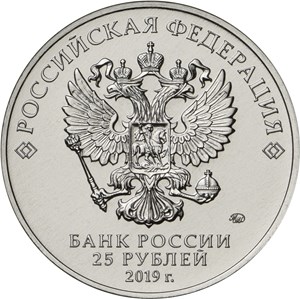Weapons Designer Vasiliy Grabin
Obverse
in the centre there is a relief image of the National Coat of Arms of the Russian Federation and over it a semicircular inscription along the rim: "РОССИЙСКАЯ ФЕДЕРАЦИЯ" (RUSSIAN FEDERATION) framed by doubled rhombuses on both sides, under the emblem, in three lines, there is an inscription: "БАНК РОССИИ" (BANK OF RUSSIA), the coin’s par value "25 РУБЛЕЙ" (25 RUBLES), and the year of issue "2019 г." (2019), and on the right there is a mint trade mark.
Reverse
a relief image of the ZIS-3 divisional gun and the inscription ‘ЗИС-3’ (ZIS-3) on the right; along the rim there are the inscriptions ‘ОРУЖИЕ ВЕЛИКОЙ ПОБЕДЫ’ (WEAPONS OF THE GREAT VICTORY) at the top and ‘В.Г. ГРАБИН’ (VASILIY GRABIN) at the bottom.
Authors
The artists: E.V. Kramskaya (obverse), A.V. Gnidin (reverse).
The sculptors: A.A. Dolgopolova (obverse), computer simulation (reverse).
Mint: Moscow Mint (ММД).
The edge: 180 corrugations.
Discover more
Vasiliy Gavrilovich Grabin (1899-1980) was a Soviet artillery designer. He led the engineering work on the ZiS-3 divisional gun.
Officially, the Red Army adopted the ZiS-3 gun in February 1942; however, the weapon came into use much earlier, in August 1941. The designer launched its development and serial production not by fiat but at his own discretion. His fast-track engineering approach reduced the time needed to design and produce the cannon, cut costs and, as a result, increased the output.
The ZiS-3 is one of the most vivid examples of this approach. It was the first piece of artillery produced on an assembly line. The cannon could be produced from cheap materials within the shortest possible time by low-skilled labourers; this meant lost pieces of artillery could be quickly replaced thus restoring its fighting efficiency, which is often crucial at war. Moreover, the cannon had a high firing rate and accuracy of shooting, and was reliable and easy to operate.
Its high in-combat, technological and operating qualities made the ZiS-3 one of the best weapons of World War II and the most mass-produced cannon in the history of the world’s artillery.


